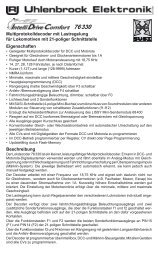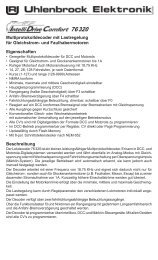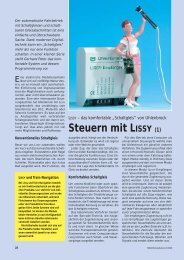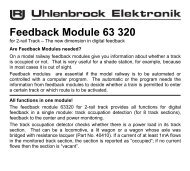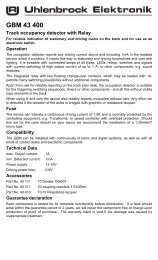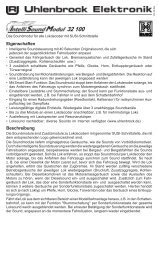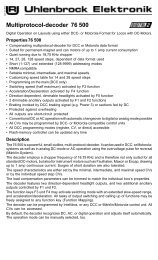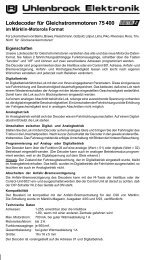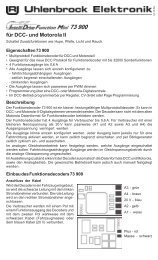Untitled - Uhlenbrock
Untitled - Uhlenbrock
Untitled - Uhlenbrock
Create successful ePaper yourself
Turn your PDF publications into a flip-book with our unique Google optimized e-Paper software.
MARCoIt is not possible to turn one function ON and another OFF in the same instruction. For thisseveral instructions must be used.Options for switching of special functionsThe changes to be performed to the special functions are specified in the LNCV for thecommand options. Here you specify if the action is travel direction dependent or not, whetherthe auxiliary function is be switched ON or OFF, or whether the state of the auxiliary function isto be changed. This means, if the function was OFF before passing the detector, it will switchON. If, on the other hand, it was ON, it will switch OFF after passing the detector. Finally theauxiliary function can also, for a defined time, switch ON and after a set time automaticallyswitch OFF again.The following table shows which values specify the various options.Computation of the command option for the change of locomotive special functionsOpt No. Description Selection Value Sum1 Do not evaluate driving direction 0Driving direction from Track1 to track2 2Driving direction from Track2 to track1 32 Switching function 2 or 3 0Automatic operation 4-12, 20-28: on arrival at the detector 0Automatic operation 4-12, 20-28: when driving off 43 Switch auxiliary function off 0Switch auxiliary function on 8Change auxiliary function 164 Auxiliary function timed change 325 Switching duration in seconds (max. 31) * 256 * 2566 Position in the sequence (0-4) * 8192 (see Chap. 7.4.6) * 8192Calculated value for LNCV 40 to 49Setting the time delay for the execution of function instructionsIn the switching operation the function instructions are executed immediately the detectors arepassed. With automatic operation the function can be executed upon arrival at the detector orwhen the locomotive is departing (see chapter 7.4.6).Timed special functionsFor switching On and/or OFF (not for toggling) a timer can be set. After this time theinstruction is reversed, i.e. the opposite Instruction is followed. e.g. there is a sound decoder,with a sound which only occurs when a particular function is switched ON. When switchingthe function OFF nothing happens. By use of the timer can you can without further effort andwithout the necessity for a further MARCo receiver, automatically switch the function off again,so that the vehicle is ready for the next power-on procedure.ExampleThe MARCo-Receiver is programmed according to the following table:Programming of function instructionsCommand LNCV ... 0 ... 1 ...,2 ... 3 ... 4 ... 5 ... 6 ... 7 ... 8 ... 9Address 2... 20000 20002 103Value 3… 33 1 2Option 4… 16 11 4130What do these instructions mean?LNCVs 20, 30 and 40 give the following instruction:With all locomotives (20000 is the locomotive Universal address), in both driving directions,when over-driving the MARCo-Receiver detectors, functions f0 (light) and f5 (smoke) aretoggled.The numerical values for the command in LNCV 30 and the command option in LNCV 40 areshown in the following two tables:33




